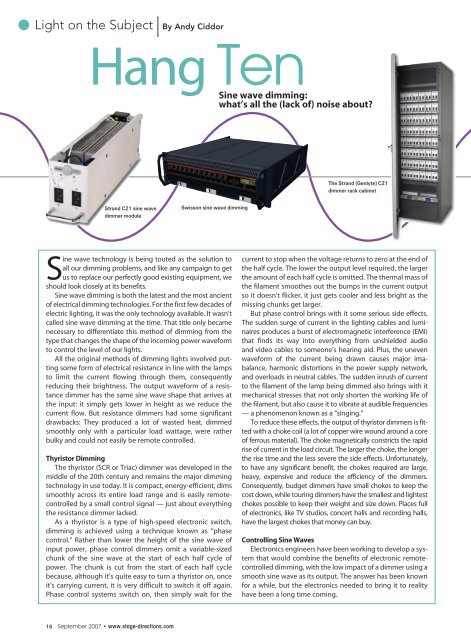Download a PDF - Stage Directions Magazine
Download a PDF - Stage Directions Magazine
Download a PDF - Stage Directions Magazine
Create successful ePaper yourself
Turn your PDF publications into a flip-book with our unique Google optimized e-Paper software.
Light on the Subject<br />
By Andy Ciddor<br />
Hang Ten<br />
Sine wave dimming:<br />
what’s all the (lack of) noise about?<br />
The Strand (Genlyte) C21<br />
dimmer rack cabinet <br />
Strand C21 sine wave<br />
dimmer module <br />
Swisson sine wave dimming<br />
Sine wave technology is being touted as the solution to<br />
all our dimming problems, and like any campaign to get<br />
us to replace our perfectly good existing equipment, we<br />
should look closely at its benefits.<br />
Sine wave dimming is both the latest and the most ancient<br />
of electrical dimming technologies. For the first few decades of<br />
electric lighting, it was the only technology available. It wasn’t<br />
called sine wave dimming at the time. That title only became<br />
necessary to differentiate this method of dimming from the<br />
type that changes the shape of the incoming power waveform<br />
to control the level of our lights.<br />
All the original methods of dimming lights involved putting<br />
some form of electrical resistance in line with the lamps<br />
to limit the current flowing through them, consequently<br />
reducing their brightness. The output waveform of a resistance<br />
dimmer has the same sine wave shape that arrives at<br />
the input: it simply gets lower in height as we reduce the<br />
current flow. But resistance dimmers had some significant<br />
drawbacks: They produced a lot of wasted heat, dimmed<br />
smoothly only with a particular load wattage, were rather<br />
bulky and could not easily be remote controlled.<br />
Thyristor Dimming<br />
The thyristor (SCR or Triac) dimmer was developed in the<br />
middle of the 20th century and remains the major dimming<br />
technology in use today. It is compact, energy-efficient, dims<br />
smoothly across its entire load range and is easily remotecontrolled<br />
by a small control signal — just about everything<br />
the resistance dimmer lacked.<br />
As a thyristor is a type of high-speed electronic switch,<br />
dimming is achieved using a technique known as “phase<br />
control.” Rather than lower the height of the sine wave of<br />
input power, phase control dimmers omit a variable-sized<br />
chunk of the sine wave at the start of each half cycle of<br />
power. The chunk is cut from the start of each half cycle<br />
because, although it’s quite easy to turn a thyristor on, once<br />
it’s carrying current, it is very difficult to switch it off again.<br />
Phase control systems switch on, then simply wait for the<br />
current to stop when the voltage returns to zero at the end of<br />
the half cycle. The lower the output level required, the larger<br />
the amount of each half cycle is omitted. The thermal mass of<br />
the filament smoothes out the bumps in the current output<br />
so it doesn’t flicker, it just gets cooler and less bright as the<br />
missing chunks get larger.<br />
But phase control brings with it some serious side effects.<br />
The sudden surge of current in the lighting cables and luminaires<br />
produces a burst of electromagnetic interference (EMI)<br />
that finds its way into everything from unshielded audio<br />
and video cables to someone’s hearing aid. Plus, the uneven<br />
waveform of the current being drawn causes major imabalance,<br />
harmonic distortions in the power supply network,<br />
and overloads in neutral cables. The sudden inrush of current<br />
to the filament of the lamp being dimmed also brings with it<br />
mechanical stresses that not only shorten the working life of<br />
the filament, but also cause it to vibrate at audible frequencies<br />
— a phenomenon known as a “singing.”<br />
To reduce these effects, the output of thyristor dimmers is fitted<br />
with a choke coil (a lot of copper wire wound around a core<br />
of ferrous material). The choke magnetically constricts the rapid<br />
rise of current in the load circuit. The larger the choke, the longer<br />
the rise time and the less severe the side effects. Unfortunately,<br />
to have any significant benefit, the chokes required are large,<br />
heavy, expensive and reduce the efficiency of the dimmers.<br />
Consequently, budget dimmers have small chokes to keep the<br />
cost down, while touring dimmers have the smallest and lightest<br />
chokes possible to keep their weight and size down. Places full<br />
of electronics, like TV studios, concert halls and recording halls,<br />
have the largest chokes that money can buy.<br />
Controlling Sine Waves<br />
Electronics engineers have been working to develop a system<br />
that would combine the benefits of electronic remotecontrolled<br />
dimming, with the low impact of a dimmer using a<br />
smooth sine wave as its output. The answer has been known<br />
for a while, but the electronics needed to bring it to reality<br />
have been a long time coming.<br />
16 September 2007 • www.stage-directions.com
















